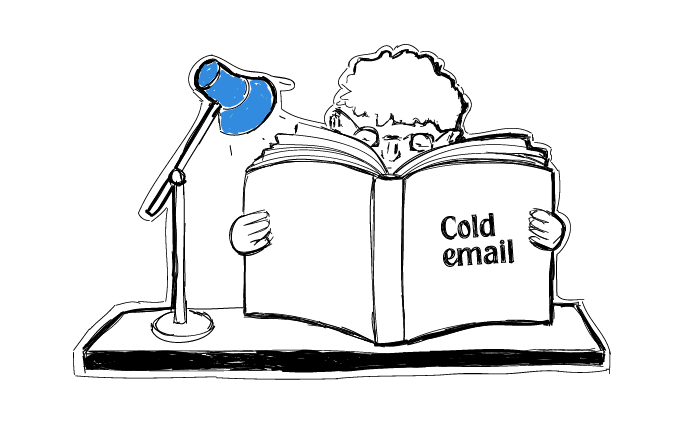I saw numerous articles, posts and videos on how to write effective cold emails.
Most of them mention the subject line, the introduction, the pitch, the CTA. Some of them mention the signature. But I couldn’t find an article enhancing the importance of the “From” line. And this is also one of the crucial elements of a cold email. In fact, it is almost as important as the subject line.
Why do we miss the importance of the “From” line?
The “From” line seems so obvious. We set it up while configuring our email account, and that’s it. What to change about it, right?
Wrong.
The “From” line is what our addressee sees right next to the subject line – even before they open the email. The “From” line, like the subject line, should be consistent with our subject, our message, and the purpose of the email.
It is a very important part of the meticulously constructed puzzle.
Personal or company email?
That depends. Usually sending a cold email we want to contact a specific person at a specific company. So to them, we should be a specific person from a specific company.
Think from the perspective of a cold email addressee. You sometimes get cold emails as well, so this shouldn’t be very hard.
Imagine you get an email from an allegedly great company, offering you their top-quality services or product, sent from “[email protected]”… Would you treat this email seriously? Would you feel safe responding to such an email? I can say I wouldn’t. DELETE.
[email protected] would definitely feel better, and I probably wouldn’t mind, if only John gave me some more information on how I can check out his company in the body of his email and/or in his signature. MAYBE OPEN (if the subject line is intriguing enough).
Now, if you see the same email sent from “[email protected]”, will you treat it more seriously and feel safer responding to this one? I would.
First of all, I would be able to check the company’s website to see who they are, where they are located, who they’ve worked with, and so on. That gives me an idea of what they do. That tells me they are professional and treat me in a professional way. OPEN.
Ok, but I could also get an email from [email protected]. How would I see such an email? I would sense impersonal bulk approach. Even if it wasn’t the case. Even if John sent all the emails to all his prospects one by one. What I think at this moment is, “if this was a personal outreach, he would use his personal account.” MAYBE OPEN (if the subject line was intriguing enough).
So, if you have your own domain, definitely use your personal email address at this domain sending the first-touch email to your addressees.
For me, that’s the first anti-spam test to pass.
And if you’re already sending cold emails at scale, see also:Why We Set up a Separate Mailbox for Outbound Campaigns? >>
What the “From” line should include
First name, or first+last name?
I usually get poorly written cold emails from people who give me just their first name, or the first and last name in the “From” line. And this would be acceptable, if only they gave me their full name and a link to their website within the email and most definitely in the signature – which, unfortunately, they don’t. DELETE.
So when is the first name and the last name enough for a “From” line? Again, that depends on the subject, the body and the purpose of your first message.
For instance, at 52Challenges we were sending first touch emails with the subject line: “I’m looking for a fitness professional”. I was sending them from my personal address at our company domain and the “From” line included only my full name. Why was that?
We assumed that when a personal trainer sees the subject sent from a real person, not a company, they feel like there is actually someone looking for their help and professional expertise. They open it thinking this might be a new client. DEFINITELY OPEN.
In the body of my email, I explained that we were looking for fitness professionals who would like to try our new software. I gave them a link to our website, so they could check me out if they wanted.
My name plus the company name?
If I put in my “From” line Cathy from 52Challenges.com, the email would definitely feel less personal, and thus less intriguing. MAYBE OPEN.
And if my “From” line would be simply 52Challenges.com, they could feel like this was just another unsolicited bulk email sent by a machine. They wouldn’t be able to see the person on the other side. DELETE.
On the other hand, at Woodpecker I’m using the “From” line Cathy from Woodpecker.co. I’m writing to people who are involved in B2B start-ups, work as sales or marketing managers and expect emails from other people involved in business. I additionally personalize the subject line, so the subject + from line is a combination of personal and professional.
So far, works great for me.
What’s in it for you?
We had a lot of examples and some analysis. But what’s to remember from all this? Well, 3 things for today:
#1 – Be consistent.
Each part of your email, even the usually ignored “From” line, should match the rest of your message. In order to open your email and respond, your addressee needs all the elements of the puzzle you are to them at first. Let them recognize you as a professional, let them recognize you as a person, let them read your good intentions so they can feel safe and treat you seriously.
#2 – Use empathy.
Once you get around constructing your cold email, think of your prospects like you were one of them. Get into their shoes for a little while. Check if you would open such an email from a person who presents themselves such-and-such. For more great points on this perspective, check the 7 Sanity Checks by Lincoln Murphy.
#3 – Be specific.
Don’t think generally. What works for another group of prospects and for another type of business may not work for yours. Think of your business as a unique unit. Think of your addressee’s as a unique audience. Think of your specific solution and their specific situation.
How do they work? What kind of emails do they expect? Who will they be willing to talk to? As soon as you’re able to answer those questions, you will be able to construct a well-targeted and highly-personalized email campaign.
Get straight to Part II of this Six-Step Effective Cold Email Tutorial:
What Subject Line Will Make My Addressees Open My Cold Email >>
READ ALSO

A Comprehensive Guide to Cold Email
This week we have a little special. I've been writing about cold emails for over 2 years. Last week I realized that I've written over 100 posts on this blog so far. That's a lot of material. So this week I decided to prepare a kind of a table of contents, so you have a place on this blog where you can easily and quickly find what you're looking for. Plus, maybe it will allow you to discover some posts you haven't read before. Check out the collection that makes a comprehensive guide to cold email.

How I wrote a cold email that got a 50% reply rate
Not 50% open rate, mind you. 50% REPLY rate. That means half of the people I wrote to actually replied to me. And 100% of those were kind replies. Not “leave me alone” or “unsubscribe” kind of replies. I started some nice conversations and got a couple of people on Skype – which was the purpose of my email. Here’s my exact copy and some comments on how I constructed it.

How to Start B2B Cold Email Outreach?
Here's what it usually looks like: we read Predictable Revenue by Aaron Ross, we read some articles by people who have succeeded in doing cold email, we download some PDFs from the people who have gained lots of new customers and partners for their businesses thanks to cold emails. We soak up all the theory until one day we think to ourselves: ok, now it's time for practice. Sooo, where do I start... I mean, what do I do literally? This post proposes an answer to this crucial question.
